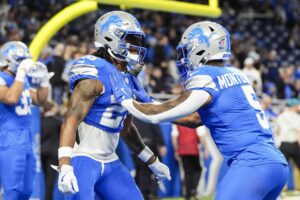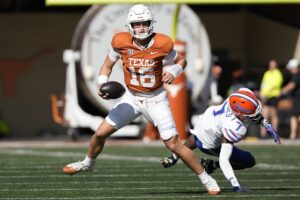All the talk about a redesigned Cleveland Browns offense went out the window with Nick Chubb’s injury in Week 2. Jerome Ford was the next man up in the backfield and has been the lone constant through the constant quarterback rotation. The 2nd-year pro was expected to develop as the team’s new Kareem Hunt, the 1B to Chubb’s 1A.
But that hasn’t happened, and it’s time for the team to admit that the Ford experiment isn’t progressing.
Jerome Ford is Inefficient
According to NFL Next Gen Stats, Ford has a running efficiency of 4.74, the fourth least efficient in the NFL. Among running backs at the top of their respective depth charts, Ford is second only behind Houston’s Dameon Pierce.
More troubling is Jerome Ford’s time behind the line of scrimmage. At 3.15 seconds, Ford spends more time behind the line than any other back in the NFL. That’s a significant problem for a team with a banged-up offensive line. Starting right tackle Jack Conklin was lost for the season in Week 1, and his counterpart, Jed Wills, will miss at least the next four games after a knee injury against the Arizona Cardinals.
How this translates to the field is Jerome Ford can’t make good decisions quickly. For example, on the Cleveland Browns first play from scrimmage against the Cardinals, Ford took the ball through the right side of the line for a respectable six-yard gain. However, a single cut to the left would have allowed Ford a nearly open field, which could have allowed for a much larger gain.
All too often, Ford’s first down rushes leave the Cleveland Browns in second and longs, putting unnecessary pressure on the passing game.
Other Cleveland Browns Backs by Comparison
The Cleveland Browns were so high on Jerome Ford that they decided not to re-sign Kareem Hunt. They also chose not to pursue any other veteran backs. The Browns front office had decided Hunt had lost a step, and he wasn’t exactly the fastest guy to begin with. Hunt’s 40-yard dash was a 4.62 when he came out in the 2017 draft. By comparison, Ford’s was 4.46 just last year.
But the Browns front office has had issues equating practice production with game production. That led them to keep kicker Cade York long past the point of reason, and those same evaluation blinders have landed on the Hunt/Ford question. Though Hunt wasn’t resigned until Week 3, he has five rushing touchdowns to Ford’s two. Hunt’s time behind the line of scrimmage is 2.65, a full half-second less than Ford’s.
Pierre Strong hasn’t gotten much of a chance in the backfield and doesn’t qualify for the NextGen stat treatment. But with his 34 carries, his yards per carry is a half-yard higher than Jerome Ford’s, and he trails the starter by just a single score.
Jerome Ford is not an RB1
Jerome Ford was never supposed to be in this position this early. But the Cleveland Browns failed to properly evaluate him, and now they’re stuck in a bad spot. The team has a historically good defense. They also have a franchise quarterback who is finally shedding the rust and returning to his former self. Cleveland is ready to win now.
If the Browns are going to make a real run at the Super Bowl, they have to start looking at mixing it up in the backfield. Hunt has found his role in the new offense. It’s time for Jerome Ford to revert to the role player he was expected to be. Because he is not the bell cow back the Cleveland Browns hoped he would be.
Main Photo Credit: Charles LeClaire-USA TODAY Sports






